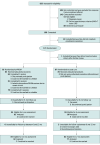Promoting Resilience in Stress Management for Adolescents With Type 1 Diabetes: A Randomized Clinical Trial
- PMID: 39158914
- PMCID: PMC11333977
- DOI: 10.1001/jamanetworkopen.2024.28287
Promoting Resilience in Stress Management for Adolescents With Type 1 Diabetes: A Randomized Clinical Trial
Abstract
Importance: Type 1 diabetes (T1D) requires demanding self-management health behaviors, and adolescents with T1D are at risk for poor psychosocial and medical outcomes. Developing resilience skills may help adolescents with T1D and elevated distress navigate common stressors and achieve positive outcomes.
Objective: To test the efficacy of the Promoting Resilience in Stress Management (PRISM) intervention on levels of hemoglobin A1c (HbA1c), diabetes distress, self-management behaviors, resilience, and quality of life among adolescents.
Design, setting, and participants: This phase 3, parallel, 1:1 randomized clinical trial that followed up 172 participants for 12 months was conducted from January 1, 2020, to November 30, 2022, at each of 2 children's hospitals, in Seattle, Washington, and Houston, Texas. Participants were ages 13 to 18 years with T1D for at least 12 months and elevated diabetes distress.
Intervention: PRISM, a manualized, skills-based, individual intervention program that teaches stress management, goal setting, reframing, and meaning-making, facilitated by a coach and accompanied by a digital app, was delivered in three 30- to 60-minute sessions approximately 2 weeks apart.
Main outcomes and measures: The 2 primary outcomes, diabetes distress and HbA1c levels, and 3 secondary outcomes, resilience, quality of life, and engagement in self-management behaviors, were assessed at baseline and 6 and 12 months after baseline. Linear mixed-effects regression models were used to evaluate associations between PRISM or usual care (UC) and these outcomes at both time points for the intention-to-treat population.
Results: Among 172 adolescents (mean [SD] age, 15.7 [1.6] years), 96 were female (56%), and their baseline mean (SD) HbA1c level was 8.7% (2.0%). No differences were evident between PRISM and UC recipients in HbA1c levels (β, -0.21 [95% CI, -0.65 to 0.22]; P = .33) or diabetes distress (β, -2.71 [95% CI, -6.31 to 0.90]; P = .14) or any participant-reported outcome (eg, β, 2.25 [95% CI, -0.30 to 4.80]; P = .08 for self-management behaviors) at 6 months. At 12 months, there was no statistically significant difference between arms in HbA1c levels (β, -0.26 [95% CI, -0.72 to 0.19]; P = .25); however, PRISM recipients reported significantly greater amelioration of diabetes distress (β, -4.59 [95% CI, -8.25 to -0.94]; P = .01) and improvement in self-management behaviors (β, 3.4 [95% CI, 0.9 to 5.9]; P = .01) compared with UC recipients.
Conclusions and relevance: The findings in this randomized clinical trial of psychosocial and behavioral improvements associated with PRISM at 12 months illustrate the value of a strengths-based intervention. Integrating resilience skills-building with traditional diabetes care may be a promising approach for improving outcomes among adolescents with T1D and elevated diabetes distress.
Trial registration: ClinicalTrials.gov number: NCT03847194.
Conflict of interest statement
Figures


References
Publication types
MeSH terms
Substances
Associated data
Grants and funding
LinkOut - more resources
Full Text Sources
Medical

